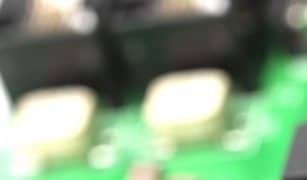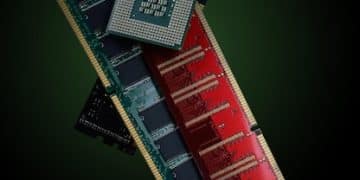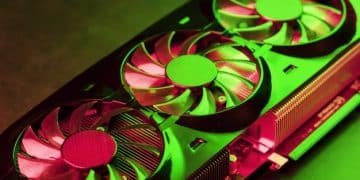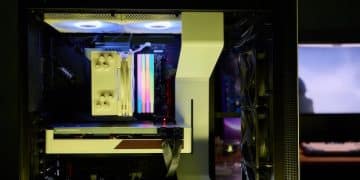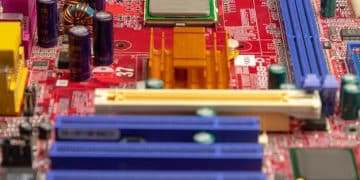Grounding Guide: Preventing Static Damage When Building a Gaming PC
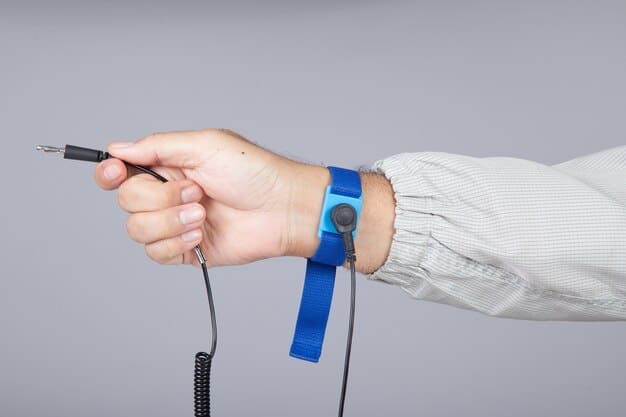
Preventing static damage is crucial when building a gaming PC; grounding yourself discharges static electricity, protecting sensitive components like the CPU, RAM, and motherboard from potentially harmful electrical shocks.
Building a gaming PC is an exciting endeavor, but it’s crucial to protect your investment from the unseen threat of static electricity. Knowing how to properly ground yourself when building a gaming PC is essential to prevent static damage, ensuring that your components function correctly for years to come.
Why Grounding Is Essential for PC Building
Static electricity, the buildup of electrical charge on a surface, is more than just an annoyance; it’s a potential hazard for sensitive electronic components. Even a small static discharge can damage or destroy parts like the CPU, RAM, or motherboard, leading to costly repairs or replacements. Proper grounding is a simple yet effective way to mitigate this risk.
By grounding yourself, you provide a safe path for static electricity to discharge, preventing it from damaging your components. Think of it as a lightning rod for your PC build, diverting the electrical charge away from the vulnerable parts. Understanding this risk is the first step to protecting your investment.
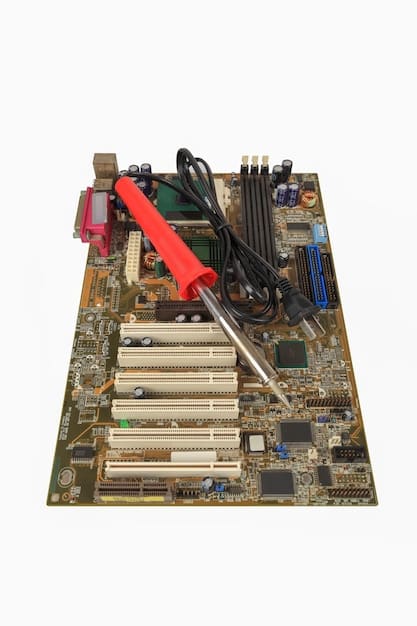
The Dangers of Static Electricity
Static electricity is generated by friction between different materials, such as your clothes rubbing against a chair or your shoes shuffling on the carpet. While you might not always feel a static shock, even a small discharge can carry thousands of volts, enough to damage electronic components. These components can be permanently damaged or suffer from reduced lifespans due to static discharge.
How Grounding Protects Your Components
Grounding creates a conductive path that safely diverts static electricity away from sensitive components. This path allows the charge to dissipate harmlessly into the ground, preventing it from building up and discharging through your PC components. By maintaining a grounded connection, you maintain an electrical potential between you and your computer components, keeping them safe during assembly.
- Prevents Damage: Grounding protects components from immediate static shock damage.
- Extends Lifespan: Reduces the risk of long-term damage, extending the lifespan of your PC.
- Ensures Stability: Stable components lead to a more reliable and consistent system performance.
Understanding the importance of grounding is the cornerstone of safe PC building. By taking the necessary precautions, you minimize the risk of static damage and ensure your components function correctly. The next sections will outline how to properly ground yourself during the build process, providing practical steps and essential tools.
Tools and Equipment for Safe Grounding
Effective grounding requires a few essential tools and equipment. While some may seem optional, each plays a critical role in minimizing the risk of static discharge during your PC build. Investing in these tools is a small price to pay for the peace of mind and protection they provide.
The key tools include an anti-static wrist strap, an anti-static mat, and a grounded power supply. Each item works in concert to create a comprehensive grounding system that protects your investment.
Anti-Static Wrist Strap
An anti-static wrist strap is a conductive strap worn around your wrist, connected to a grounded source via a wire. This strap ensures that any static electricity that builds up on your body is safely discharged to the ground before it can damage components. The wrist strap should fit snugly but comfortably, ensuring consistent contact with your skin.
Anti-Static Mat
An anti-static mat provides a safe work surface for your components. Made of a conductive material, the mat dissipates static electricity and prevents charge buildup. When working on your PC, place the components on the mat to protect them from static discharge. Ensure the mat is properly grounded, usually via a connection to a grounded point like the computer case.
Grounded Power Supply
A grounded power supply serves as a convenient and reliable grounding point. By plugging the power supply into a grounded outlet and connecting your anti-static wrist strap to the case, you can ensure a continuous path to ground. The power supply does not need to be turned on; it simply needs to be plugged in to provide a ground connection.
- Wrist Strap Proper Fit: Ensure the wrist strap fits well for optimal grounding.
- Mat Placement: Use the anti-static mat as the primary workspace for components.
- Power Supply Grounding: Always ground to a properly grounded power supply.
By gathering these essential tools and equipment, you create a secure environment for assembling your PC. Proper preparation ensures not only protection against static discharge but also peace of mind during the build process.
Preparing Your Workspace for Grounding
Setting up your workspace correctly is crucial for effective grounding. A well-prepared workspace minimizes the risk of static electricity buildup and creates a safe environment for handling sensitive components. It’s not just about having the right tools; it’s about creating the right conditions.
Cleaning your workspace, organizing components, and grounding your work surface are all essential steps in preparing for a safe PC build.
Clean Your Workspace
A clean and uncluttered workspace reduces the risk of static buildup. Dust and debris can hold static charge, increasing the potential for discharge. Use a static-safe cleaner to wipe down your work surface and remove any particles that could cause issues. Also, try to avoid working in carpeted areas if possible, as carpet can generate significant static electricity.
Keep Components Organized
Keeping components organized minimizes unnecessary handling and movement, reducing the chance of static buildup. Use anti-static bags or containers to store components until they are ready for installation. Clearly labeling each component prevents confusion and ensures you handle them with care.
Ground Your Work Surface
Grounding your work surface involves connecting your anti-static mat to a grounded point. Most anti-static mats come with a grounding wire that can be attached to a grounded power supply or another reliable ground source. Ensure the connection is secure and stable before you begin working. This creates a complete grounding system that protects both you and your components.
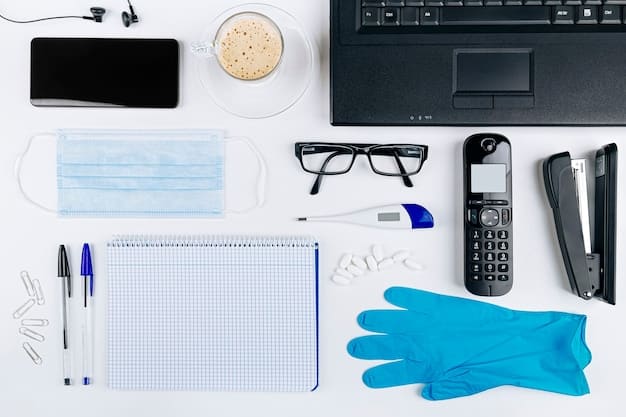
- Regular Cleaning: Clean your workspace regularly to minimize dust.
- Proper Storage: Store components in anti-static bags when not in use.
- Secure Grounding: Ensure all grounding connections are secure.
By taking the time to properly prepare your workspace, you create a safe and efficient environment for building your PC. These precautions not only protect against static discharge but also contribute to a smoother and more enjoyable building experience.
Step-by-Step Guide to Grounding Yourself
Now that you have the tools and a prepared workspace, it’s time to put the grounding principles into practice. Following a step-by-step guide ensures that you consistently maintain a safe, grounded connection throughout the PC building process.
From wearing the anti-static wrist strap to connecting it to a grounded source, each step is critical to safeguarding your components.
Wear the Anti-Static Wrist Strap
Start by putting on the anti-static wrist strap. Ensure it fits snugly around your wrist, making good contact with your skin. Adjust the strap as needed to achieve a comfortable but secure fit. The strap is your primary line of defense against static discharge, so it’s essential to wear it correctly.
Connect the Wrist Strap to a Grounded Point
Next, connect the wrist strap’s alligator clip to a grounded point. A common and reliable option is the metal case of your power supply, which should be plugged into a grounded outlet. The power supply does not need to be turned on; simply plugging it in provides the necessary ground. Ensure the connection is to bare metal and not a painted surface, as paint can act as an insulator.
Test the Connection
Before beginning to handle any components, test the connection to ensure that it is properly grounded. Many wrist straps come with a built-in tester that will indicate whether the connection is secure. If your strap does not have a tester, you can use a multimeter to check the continuity between the wrist strap and the grounded point. This step confirms that static electricity will be safely discharged.
- Proper Fit: Make sure the wrist strap fits snugly on your wrist.
- Secure Connection: Connect the clip to bare metal on a grounded power supply.
- Regular Testing: Test the grounding connection before handling components.
By following this step-by-step guide, you establish a secure and reliable grounding system. Consistently maintaining this connection throughout the build process is crucial for preventing static damage to your valuable PC components. By keeping yourself grounded you ensure safe handling and assembly.
Best Practices for Handling PC Components
Even with proper grounding, the way you handle PC components is a important. Practicing safe handling techniques further minimizes the risk of static discharge and physical damage to your hardware. Care and attention to detail can make a big difference in the longevity and performance of your PC.
Touching components unnecessarily, handling them by their sensitive parts, or exposing them to static-prone environments should be avoided.
Avoid Touching Sensitive Parts
When handling components, avoid touching sensitive parts such as the pins on CPUs and GPUs or the gold contacts on RAM modules. These parts are more susceptible to static damage and physical damage. Instead, hold components by their edges or non-conductive surfaces. This technique reduces the risk of static discharge and prevents contaminants from interfering with connections.
Use Anti-Static Bags
When not actively working with a component, store it in an anti-static bag. These bags are designed to protect components from static buildup and physical damage. Ensure the bag is properly sealed to maintain its protective properties. Properly storing components keeps them safe and ready for installation.
Handle Components over the Anti-Static Mat
Always handle components over the anti-static mat. The mat provides a safe, grounded surface that dissipates static electricity and prevents charge buildup. This practice ensures that any static discharge is safely redirected away from the components. The mat should be the primary workspace whenever you are handling or assembling parts.
- Avoid Touching Pins: Protect sensitive pins on CPUs and GPUs.
- Use Anti-Static Bags: Store components in anti-static bags when not in use.
- Work on Mat: Always handle components over the anti-static mat.
By adhering to these best practices, you enhance the effectiveness of your grounding system and minimize the risk of damage to your PC components. Safe handling techniques, combined with proper grounding, ensure a long-lasting and reliable gaming PC.
Troubleshooting Common Grounding Issues
Even with the best preparation, grounding issues can still occur. Recognizing and troubleshooting these issues can prevent potential damage to your components and ensure a safe PC building process. Knowing how to identify and resolve common problems is important.
Loose connections, improper grounding points, and faulty equipment are some common issues that may arise.
Loose Connections
A loose connection in your grounding system can compromise its effectiveness. Regularly check the connection points between your wrist strap, the anti-static mat, and the grounded power supply to ensure they are secure. A multimeter can be used to confirm continuity and identify any breaks in the grounding path. Correct any loose connections immediately to maintain a secure ground.
Improper Grounding Points
Using an improper grounding point can render your grounding system ineffective. Painted surfaces, ungrounded outlets, or other unreliable sources can prevent static electricity from safely discharging. Always use a known and verified grounded point, such as the metal case of a power supply plugged into a grounded outlet. Ensure the grounding point is free of paint or other insulators that could impede the connection.
Faulty Equipment
Faulty equipment, such as a damaged wrist strap or a non-conductive anti-static mat, can pose a risk to your components. Inspect your equipment regularly for wear and tear. Test the conductivity of your anti-static mat and the continuity of your wrist strap to ensure they are functioning correctly. Replace any faulty equipment immediately to maintain a reliable grounding system.
- Check Connections: Regularly inspect grounding connections for looseness.
- Verify Grounding Point: Ensure you are using a reliable and verified ground.
- Inspect Equipment: Check the condition of your wrist strap and anti-static mat.
By troubleshooting grounding issues promptly, you can avoid potential damage and ensure a safe PC building experience. Maintaining a vigilant approach protects your components and provides peace of mind throughout the build process.
| Key Point | Brief Description |
|---|---|
| 🖐️ Anti-Static Wrist Strap | Essential for discharging static electricity from your body. |
| 💼 Anti-Static Mat | Provides a safe, grounded workspace for handling components. |
| 🔌 Grounded Power Supply | Serves as a reliable grounding point when plugged in. |
| 🛡️ Safe Handling | Avoid touching sensitive parts; use anti-static bags for storage. |
FAQ
▼
Grounding prevents static electricity from damaging sensitive PC components like the CPU, RAM, and motherboard. Static discharge can cause immediate or long-term damage, so grounding is important.
▼
The basic tools include an anti-static wrist strap, an anti-static mat, and a grounded power supply. These create a safe, grounded environment for assembling your PC.
▼
Wear it snugly around your wrist and connect the clip to a grounded metal surface, such as the case of a power supply that’s plugged into a grounded wall outlet.
▼
While possible, it is risky. An anti-static wrist strap is a simple and effective precaution that greatly reduces the risk of static discharge damaging components during the build.
▼
It’s a good practice to check your grounding connection periodically, especially if you move around or adjust your setup. A quick test ensures continuous protection.
Conclusion
Properly grounding yourself is a critical step in preventing static damage when building a gaming PC. Investing in the right tools, preparing your workspace, following safe handling practices, and troubleshooting potential issues can save you from costly repairs or replacements. By prioritizing these precautions, you ensure your components function correctly.
